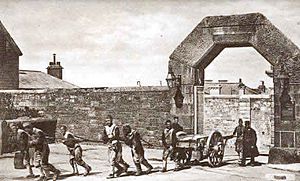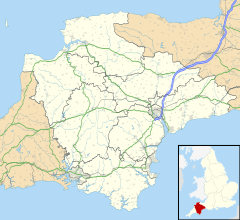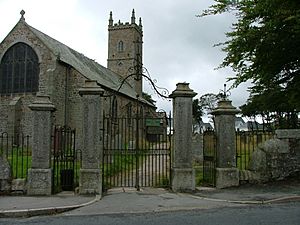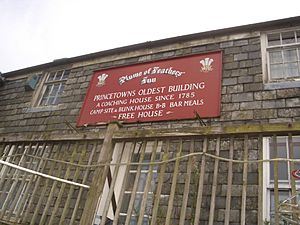Princetown facts for kids
Quick facts for kids Princetown |
|
|---|---|
Jubilee Memorial and Railway Inn, Princetown |
|
| OS grid reference | SX588736 |
| • London | 181 miles (291 km) |
| Civil parish |
|
| District |
|
| Shire county | |
| Region | |
| Country | England |
| Sovereign state | United Kingdom |
| Post town | YELVERTON |
| Postcode district | PL20 |
| Dialling code | 01822 |
| Police | Devon and Cornwall |
| Fire | Devon and Somerset |
| Ambulance | South Western |
| EU Parliament | South West England |
| UK Parliament |
|
Princetown is a small village located inside the Dartmoor National Park in Devon, England. It's the main village in the area known as Dartmoor Forest.
This village started in 1785. A man named Sir Thomas Tyrwhitt, who worked for the Prince of Wales, rented a big piece of moorland. He hoped to turn it into good farmland. He encouraged people to move there and even suggested building a prison. He named the new settlement Princetown after the Prince of Wales.
Princetown is home to Dartmoor Prison. It's about 435 meters (1,430 feet) above sea level, making it one of the highest villages in the United Kingdom. It's also the biggest village on the high moor. The Princetown Railway, which closed in 1956, was also the highest railway line in England. Its station in Princetown was at the same high elevation.
History
In 1780, a farm was started near a place called Two Bridges. Then, in 1785, Sir Thomas Tyrwhitt began to improve the moorland at a spot he called Tor Royal. This is about 1 kilometer (0.6 miles) south-east of Princetown today. The Plume of Feathers Inn, a local pub, also dates back to this time. Sir Thomas built an estate and a house in 1798. Later, roads were built, connecting Princetown to Tavistock and other parts of the moor.

Sir Thomas also suggested building a prison on Dartmoor. This was to hold thousands of prisoners from the Napoleonic Wars and the later War of 1812. There were too many prisoners for the existing jails and prison-ships in Plymouth. The land for the prison was given by the Prince of Wales, who owned the Dartmoor lands. This is why the village is called Princetown. Dartmoor Prison was built in 1806 and cost £130,000. At one time, it could hold between 7,000 and 9,000 prisoners. Today, it holds about 640.
A small town grew up around the prison. Two large inns were built during the war: the Prince of Wales (which is still there) and the former Devil's Elbow / Railway Inn (now the Ramblers' Rest Guesthouse). Many prisoners had money from their home countries. Some even made their own money at night, including fake bank notes, which they used in the daily market held inside the prison.
When the prison closed in 1816, the town almost disappeared. But the Princetown Railway was completed in 1823, bringing many people back to work in the granite quarries. The prison stayed empty until 1851, when it reopened for prisoners serving long sentences. It has been made much bigger since then. Although it was planned to close in 2023, a new agreement means it will stay open longer.
In the 1880s, a building for prison officers was built. It was a place for officers and their families to relax. It closed in 2001 because most officers no longer lived in Princetown.
The houses now called Moor Crescent were built in 1912 for senior prison officers. They were used for this purpose until the 1980s. After becoming very run-down, they were fixed up and are now private homes. Hessary Terrace and Heather Terrace were also built for prison officers.
Princetown has a sports field, now called Legend Park, used by the Princetown Football Club. This field and its pavilion (now the Princetown Pavilion Youth Club) were built in the 1890s for the prison wardens.
Geography
The village is on the B3212 road, between Yelverton and Two Bridges. It is surrounded by open moorland. Many walking paths cross the moor and go through the village.
Tor Royal Lane is a road that leads from the village to the old Whiteworks tin mine. This mine is about 3 kilometers (2 miles) south-east of Princetown. It overlooks Fox Tor Mires, which is thought to be the "Grimpen Mire" from Arthur Conan Doyle's famous story, The Hound of the Baskervilles. Conan Doyle stayed at the old Duchy Hotel while writing this story. The hotel is now the National Park Visitor Centre. It's a great place to visit, with interactive displays, films, and a special area for kids.
Other interesting places in the village include the prison museum, which used to be the prison dairy. Behind the prison, there are two cemeteries. One is for French prisoners of war, and the other is for American prisoners of war. They died in the prison when it was a war camp during the Napoleonic War in the 1800s. The cemetery around the Church of St Michael and All Angels has graves of convicts who died in the prison. The Church of St Michael is special because it's the only church in England built by prisoners of war. It's now looked after by the Churches Conservation Trust. The United Church of Princetown is at the other end of the village.
The village is overlooked by North Hessary Tor to the north-west. On top of this tor is a tall transmitting mast. It's a useful landmark for walkers on the moor.
Community and People
Most people living in Princetown are white British. They live in a mix of social and private homes. The local primary school, built in 1874 for the children of prison officers, had 74 children in 2019 and was rated 'Good'. Another 17 children attend the pre-school, which is in the Community Centre.
In 2016, Princetown had about 1,447 residents, plus 640 people in the prison. Most people who live in Princetown travel to work in Plymouth or Tavistock. However, a local brewery has created a few more jobs in the village. The number of people living in Princetown is expected to grow. This is because the village has better facilities and many young people live there.
Princetown is being improved and expanded. New private houses have been built, and a football pitch with parking has been added behind the Community Centre. The High Moorland Visitor Centre is now called the National Park Visitor Centre. The area outside the center has new artwork and seating.
Economy
Princetown is a popular place for tourists. It's a great base for people exploring the moors. You'll often see large groups of hikers, walkers, and cyclists, especially in summer. The village has a bunkhouse and camping sites, along with a few local shops.
Many cycling and running events happen here. The Dartmoor Ultra Marathon takes place every year, as does the charity Tour de Moor cycle race. The annual Dartmoor Classic cycling event often goes through Princetown. The Tour of Britain cycle race has also passed through Dartmoor and Princetown.
Princetown has a brewery. It used to be in the Prince of Wales pub, but now it's in a modern building on the edge of the village. The other main pub is the Plume of Feathers. In 2017, plans were approved to build a whisky distillery. This involved changing some older buildings. The distillery building is almost finished in early 2024.
In recent years, Princetown has seen new developments. The Princetown Centre for Creativity opened in Duchy Square. This used to be a supermarket but now houses different businesses. A new village community center opened in 2008. It also has a doctor's surgery, a library, and a pre-school.
Climate
Princetown, like the rest of Dartmoor, has colder and wetter weather than most of Devon. This is mainly because it's so high up. Snow is not common, but when it does fall, it's usually heavy. The climate is similar to an oceanic climate.
| Climate data for Princetown, Elevation: 453 m (1,486 ft), 1981–2010 normals | |||||||||||||
|---|---|---|---|---|---|---|---|---|---|---|---|---|---|
| Month | Jan | Feb | Mar | Apr | May | Jun | Jul | Aug | Sep | Oct | Nov | Dec | Year |
| Mean daily maximum °C (°F) | 6.1 (43.0) |
5.9 (42.6) |
7.7 (45.9) |
10.3 (50.5) |
13.3 (55.9) |
16.1 (61.0) |
17.7 (63.9) |
17.5 (63.5) |
15.4 (59.7) |
11.9 (53.4) |
8.7 (47.7) |
6.6 (43.9) |
11.5 (52.7) |
| Daily mean °C (°F) | 3.7 (38.7) |
3.4 (38.1) |
5.0 (41.0) |
6.9 (44.4) |
9.8 (49.6) |
12.6 (54.7) |
14.5 (58.1) |
14.3 (57.7) |
12.4 (54.3) |
9.3 (48.7) |
6.5 (43.7) |
4.3 (39.7) |
8.6 (47.4) |
| Mean daily minimum °C (°F) | 1.2 (34.2) |
0.8 (33.4) |
2.2 (36.0) |
3.4 (38.1) |
6.2 (43.2) |
9.0 (48.2) |
11.2 (52.2) |
11.1 (52.0) |
9.3 (48.7) |
6.6 (43.9) |
4.2 (39.6) |
1.9 (35.4) |
5.6 (42.1) |
| Average precipitation mm (inches) | 218.1 (8.59) |
161.4 (6.35) |
158.6 (6.24) |
112.2 (4.42) |
113.4 (4.46) |
111.8 (4.40) |
142.1 (5.59) |
134.8 (5.31) |
149.4 (5.88) |
232.8 (9.17) |
227.3 (8.95) |
236.5 (9.31) |
1,998.3 (78.67) |
| Average precipitation days (≥ 1.0 mm) | 18.3 | 14.4 | 16.2 | 13.9 | 13.1 | 11.8 | 13.9 | 13.5 | 13.4 | 18.0 | 18.3 | 17.8 | 182.6 |
| Source: Met Office | |||||||||||||
Transport
A summer bus service called the Dartmoor Explorer started in 2021. It runs across the moor to Moretonhampstead and then to Exeter. There is also a daytime bus service (number 98) that connects Princetown to Yelverton and Tavistock, but it only runs three times a day.
See also
 In Spanish: Princetown para niños
In Spanish: Princetown para niños




